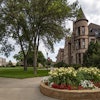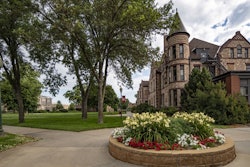MYSTIC Conn. — Artifacts of a battle between a Native American tribe and English settlers, a confrontation that helped shape early American history, have sat for years below manicured lawns and children’s swing sets in a Connecticut neighborhood.
A project to map the battlefields of the Pequot War is bringing those musket balls, gunflints and arrowheads into the sunlight for the first time in centuries. It’s also giving researchers insight into the combatants and the land on which they fought, particularly the Mystic hilltop where at least 600 Pequot Indians died in a 1637 massacre by English settlers.
Historians say the attack was a turning point in English warfare with native tribes. It nearly wiped out the powerful Pequots and showed other tribes that the colonists wouldn’t hesitate to use methods that some consider genocide.
The battle site was farmland for years before being developed in the mid-20th century into a residential neighborhood of tidy Capes, Colonials and ranch homes. A “Tree of Peace” is planted at a hilltop traffic circle that marks the center of an old Pequot fort.
“We never thought much about it when we moved here, though we’d get calls once in a while from researchers,” said Doris Oliver, who has lived on Pequot Avenue on the northern part of the battle zone with her husband, Ed, since the 1940s.
This summer, teams of researchers are scouring the Olivers’ yard with metal detectors, notebooks, small shovels and other archaeological tools.
It’s not unusual for old battlefields to be on private land. A 2007 Congressional report found 62 percent of known American battlefields are on what is now private property.
In Mystic, the work is being done only where landowners agree to it. None of the land can be taken over by the government or the Pequots, or restricted in use.
The work, being done with grants from the National Park Service’s American Battlefield Protection Program, will also look at related Pequot War battle spots elsewhere in Connecticut, on Rhode’s Island’s Block Island and in Dover Plains , N.Y.
The Pequot War, waged from 1636 to 1638, broke out as tensions escalated between that powerful tribe and English settlers, who were bolstered by other tribes angry at the aggressive Pequots.
After the Pequots’ fort was burned, those who escaped were slaughtered as they fled or caught and enslaved, either by the English or their tribal allies.
Today, the Mashantucket Pequots descendants of survivors given to the Mohegans as slaves operate the Foxwoods Resort Casino. Another group, the Eastern Pequots, descend from survivors enslaved by the Narragansetts and live in nearby North Stonington.
Members of both tribes are part of this summer’s battlefield mapping and archaeology project, a joint venture between the Mashantucket Pequot Museum & Research Center at Foxwoods and the University of Connecticut.
“A lot of people think the Pequot War was just the one massacre, this single site, but it’s so much more than that,” said Joseph Peters Jr., 24, a Mashantucket Pequot and UConn student. “There’s so much culture sitting under the ground, under the earth, for so long just waiting to be discovered.”
The researchers have already found remnants of English metal uniform buttons, bandoliers and other items that might help mark where settlers marched, camped before the attack and retreated afterward. The artifacts are being cataloged at the museum and will be kept and displayed there.
“I tell people all the time, history and archaeology are right in your backyards, right under your feet, and this is a classic example of that,” Connecticut State Archaeologist Nicholas Bellantoni said.
“The Pequot War is a short time ago, actually, by an archaeologist’s reckoning, so absolutely the potential is there to recover some very significant artifacts,” he said.
Dr. Kevin McBride, who’s leading the mapping project, said they still have to sort through “a lot of background noise” at the sites, including old coins, bottle caps and other useless items left from centuries of occupation.
“You’re either good or lucky in this work. Maybe we’ve been a little of both,” said McBride, a UConn anthropology professor and research director of the Pequot museum.
Despite the centuries that have passed, emotions over the Mystic battle still run high in eastern Connecticut. The “Tree of Peace” atop Pequot Hill is the fourth of its kind; vandals chopped down the first three.
The dig area sits in a quiet neighborhood in Mystic, a coastal town that draws tourists with an aquarium and a large maritime museum that recreates a 19th century fishing and shipbuilding village. The phenomenal success of the Foxwoods casino has brought heavy traffic to the area, angering some in the once-sleepy region.
Some homeowners even worried that the wealthy Mashantucket Pequots could use the archaeology project as a way to take their property. McBride says convincing the landowners that the Pequots can’t do so has been one of his biggest challenges.
Historians are split to this day on whether the Pequots were victims of cruel English settlers who wanted their land or brought the attack on themselves by raiding a settlement a month earlier in Wethersfield, killing nine people and carrying off two girls.
The researchers in Mystic aren’t taking sides.
“I’m just trying to figure it out,” McBride said. “When you try to be really open to the facts of all sides is when you’re going to find some amazing new things.”















